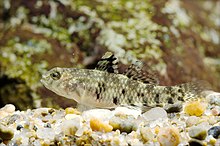| Redigobius | |
|---|---|

| |
| Redigobius bikolanus | |
| Scientific classification | |
| Domain: | Eukaryota |
| Kingdom: | Animalia |
| Phylum: | Chordata |
| Class: | Actinopterygii |
| Order: | Gobiiformes |
| Family: | Oxudercidae |
| Subfamily: | Gobionellinae |
| Genus: | Redigobius Herre, 1927 |
| Type species | |
| Gobius sternbergi H. M. Smith, 1902 | |
| Synonyms | |
| |
Redigobius is a genus of fish in the goby family, Oxudercidae, known commonly as dualspot gobies. They are native to the western Indo-Pacific region, where they occur in estuaries and freshwater habitats just above the tidal influence.
Some of these gobies are abundant fish species. The most widespread is the speckled goby (R. bikolanus), which occurs throughout the western Pacific Ocean and from Australia to Africa. Some Redigobius are kept as aquarium pets. The Fijian endemic Lever's goby (R. leveri) is featured on the ten-dollar bill in the 2013 series of Fijian currency.
Species
There are currently 15 recognized species in this genus.
Species include:
- Redigobius amblyrhynchus (Bleeker, 1878)
- Redigobius balteatops (J. L. B. Smith, 1959) (bull goby)
- Redigobius balteatus (Herre, 1935) (rhinohorn goby)
- Redigobius bikolanus (Herre, 1927) (speckled goby)
- Redigobius chrysosoma (Bleeker, 1875) (spotfin goby)
- Redigobius dewaali (M. C. W. Weber, 1897) (checked goby)
- Redigobius dispar (W. K. H. Peters, 1868)
- Redigobius isognathus (Bleeker, 1878)
- Redigobius lekutu Larson, 2010
- Redigobius leveri (Fowler, 1943) (Lever's goby)
- Redigobius macrostoma (Günther, 1861) (large-mouth goby)
- Redigobius nanus Larson, 2010
- Redigobius oyensi (de Beaufort, 1913)
- Redigobius penango (Popta, 1922)
- Redigobius tambujon (Bleeker, 1854) (Roemer's goby)
References
- Redigobius. Atlas of Living Australia.
- ^ Larson, H. K. (2010). "A review of the gobiid fish genus Redigobius (Teleostei: Gobionellinae), with descriptions of two new species". Ichthyological Exploration of Freshwaters. 21 (2): 123–91.
- Froese, Rainer; Pauly, Daniel, eds. (2011). "Redigobius bikolanus". FishBase.
- Jenkins, A. P. Fiji freshwater fish graces new 10-dollar bill: Bringing freshwater fish into the popular consciousness. Saving Freshwater Fishes and Habitats: Newsletter of the IUCN SSC/WI Freshwater Fish Specialist Group. Issue 2. June, 2013. pg. 10.
- Froese, Rainer; Pauly, Daniel (eds.). "Species in genus Redigobius". FishBase. July 2024 version.
| Taxon identifiers | |
|---|---|
| Redigobius | |
This Gobionellinae-related article is a stub. You can help Misplaced Pages by expanding it. |